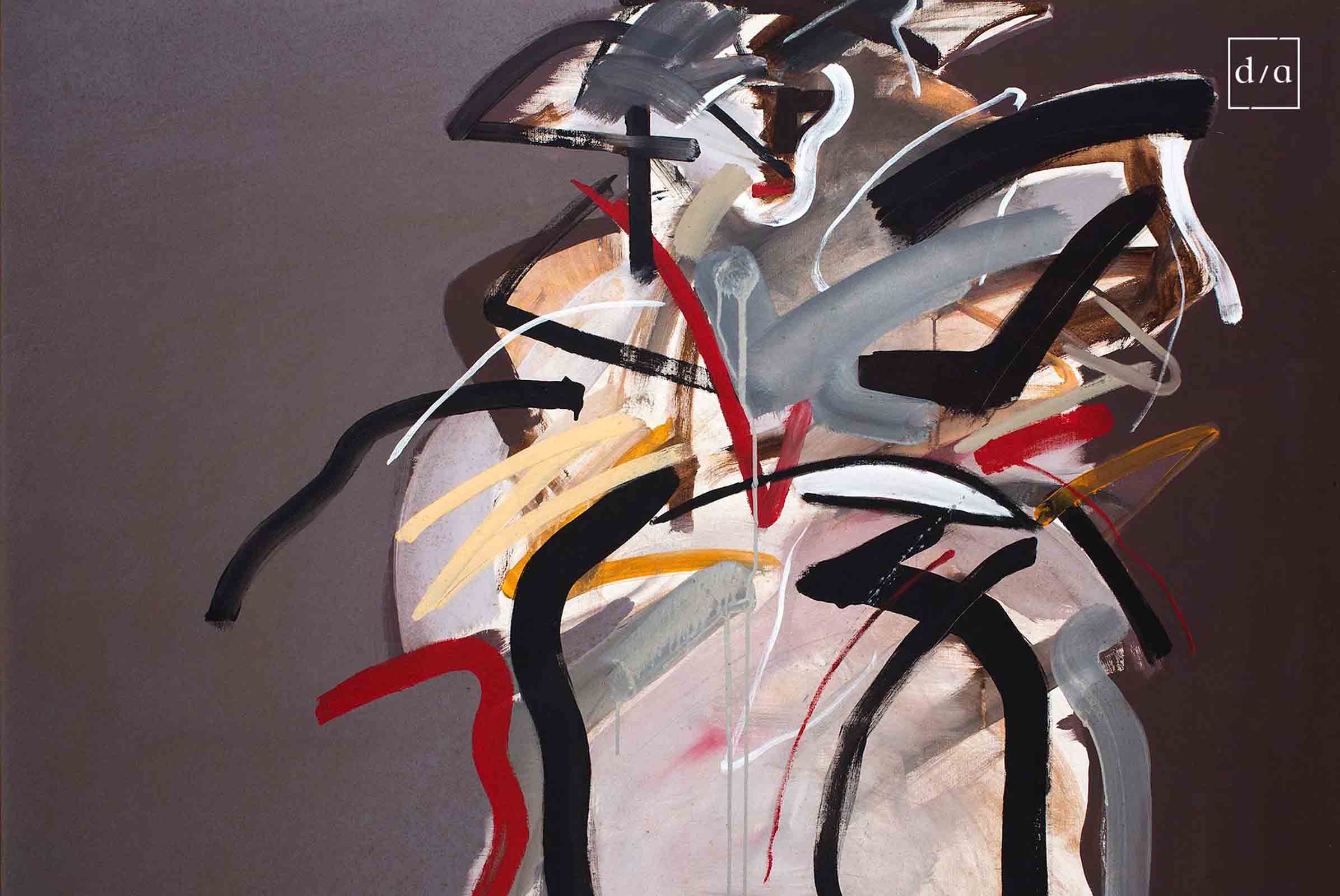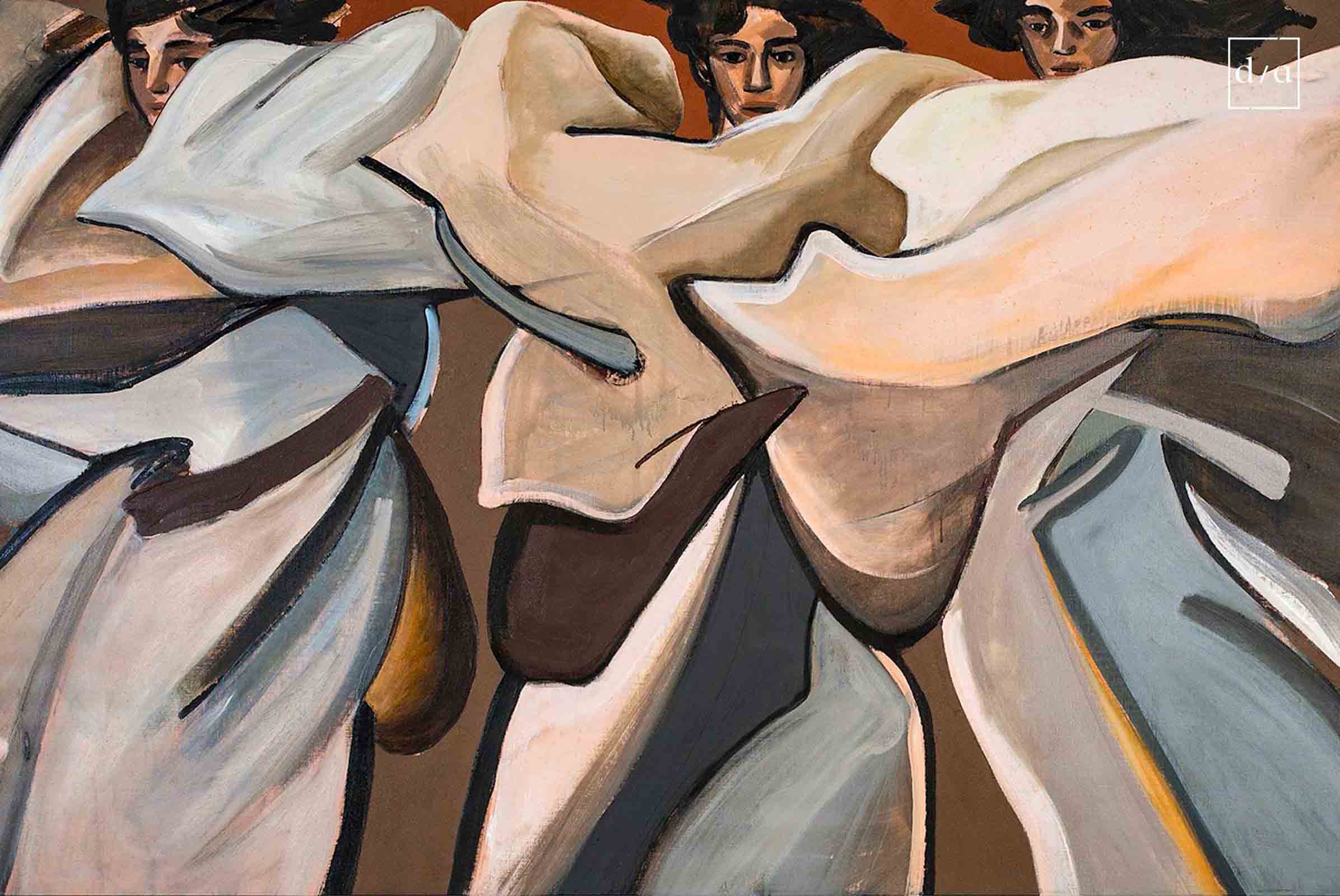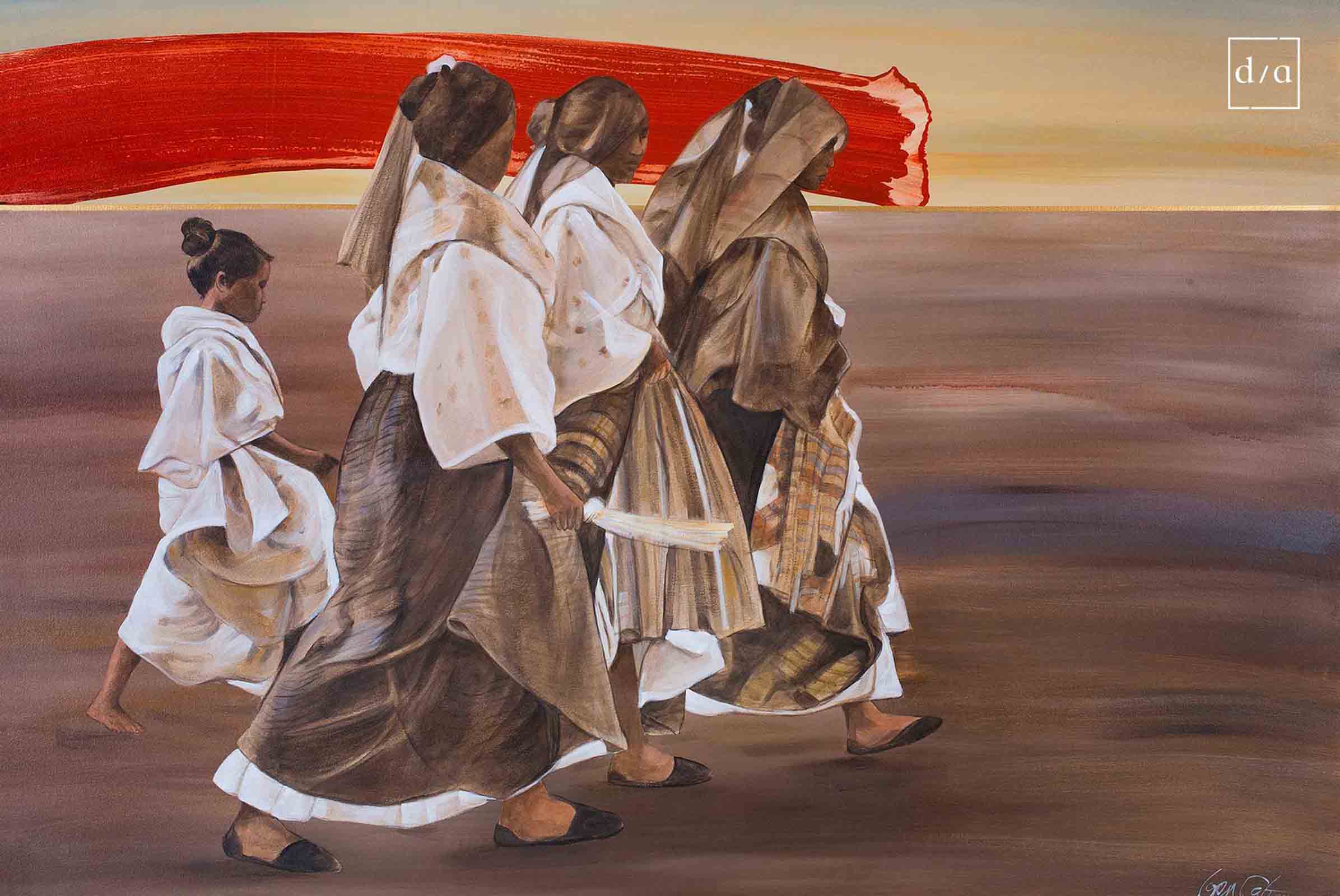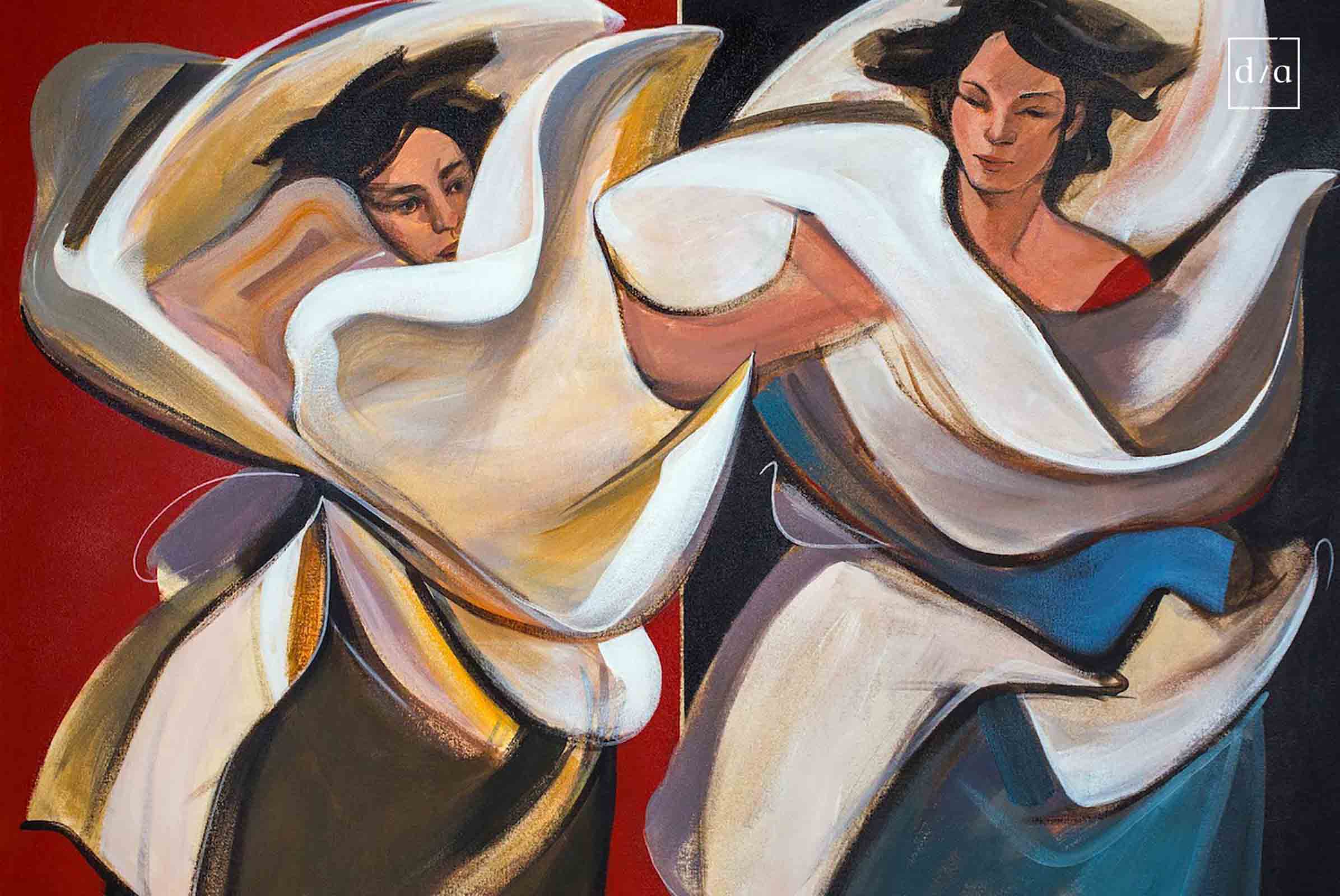New Identity

In 2016, Philippines National Artist Benedicto Cabrera, popularly known as BenCab, became the first Asian artist to collaborate with Dutch brand Moooi Carpets. Design Anthology’s managing editor Phil Annetta caught up with BenCab and Moooi Carpets CEO Martien Valentijn at the launch event in Manila this past May for their thoughts on the results.
Design Anthology: Ben, you moved to London in the sixties for personal reasons. Did you also feel that it would help your work?
BenCab: Yes, in 1969. I met my wife-to-be in Manila and then we decided to go to London and live there. I did feel it would help my work — at age 27 I’d never been out of the country. I had my first exhibit a year after I got there. I met someone who introduced me to the actress Glenda Jackson — she was setting up a gallery and I was the first exhibit in her gallery in Greenwich. It was during that time that I decided to become a full-time painter.
After that you famously discovered some colonial-era material that depicted the Philippines from an Orientalist perspective. What were your impressions of that material when you found it?
Well, the trend then was minimalism, so I tried doing a few of those works but I wasn’t happy with them. And I just felt nostalgic and I started collecting turn-of-the-century travel books. I discovered all these old photos and how the Europeans or Americans saw Filipinos, like depictions of Filipinos waiting to become American — this was when we were being subjugated. And then the idea of the Filipina as a domestic helper, you know.
So I started doing research on that and I did a whole series of Filipiniana material. That was the basis of my first exhibit not in London but back in the Philippines — that was in ’72, just prior to martial law under Marcos.
And that was the Larawan series?
That was Larawan 1. After that I did Larawan 2, which was the Filipinos abroad. I’d say it hasn’t changed. The nineteenth-century servant girl Filipina becomes a domestic helper in this century. I was making a parallel.
You’re widely known as a painter but you’ve worked across a whole range of media. What is it about painting that keeps you coming back?
Well, I like working with my hands and I’m really, in a way, a graphic artist — I worked in a magazine for five years and that helped me use that technique to work on my painting. I guess that’s why it has some appeal, too. Like I said, it’s my subject — humanistic. And it’s slightly political but not propaganda.
You can’t count propaganda as art, right? It’s not interpretive.
Yes. And during that time under Marcos a lot of artists went into that: Anti-Marcos and revolution. And of course during that time there was the Vietnam War. But that was exciting in a way. It gives you a lot of references to what’s going on around you.
What about parallels for now? Are you seeing any in the way martial law happened here?
It’s coming around again. It seems to be an international phenomenon. We have Duterte, Trump, Erdogan… it’s unbelievable how the people feel that these people are the ones who really lift us. But instead it’s the other way around. Humanism is at risk.
I read that it’s bringing you back to painting.
Well actually, we had an anti-EJK show — that’s extra-judicial killings, which is not just killing but a process of ‘justice’. In the Far Eastern University circle, pop artists had a show and I joined them, reminding them that we fought against martial law. You have this president who’s an admirer of Marcos, and he even brought Marcos to the Libingan ng Mga Bayani, the heroes’ burial ground.
That form of populist identity politics defines one group negatively, whereas your work is so accessible because the humanism is universal. Is that something you try for? Do you feel your work gives a more positive identity to Filipinos?
I think it’s become like that in a way because it’s become so popular. But at the same time, if there’s a crisis in humanity, I go back to that, to what affects me politically. We’re going to have an exhibit in June at the University of the Philippines, and I did a very large drawing of humanity in crisis.
What I’m trying to portray through humanism is everybody gets affected by things like disasters, whether you’re rich or poor, you’re affected. And I did the whole series on disasters after the big earthquake… I consider myself as observational.
When you chose the works for the carpets, did you really want to show that kind of humanism again? What influenced the choice?
I have some works that are more … pleasant (laughs), with the subject of the Filipina, so with the Abitare group and us, we sort of compromised on that because we have to think of it as a carpet as well, not just a statement! I envisioned what would be good on a wall — something very strong.
Had you created design objects before?
I created two Swatch designs using my image of Sabel. Sabel can be abstract and it can be realistic. I love drawing from life and I did a whole series on Filipino musicians, mostly alternative music. I like direct drawing. I did seventy drawings and came out with a book.
Is it the immediacy that draws you?
Yes, I like the immediacy. Also nudes — I love drawing nudes.
What did you think when Abitare approached you about the carpets?
I’m always open to new media. I met this friend who said, ‘Why don’t you do some sculptures?’ and for me it was a challenge. So we started doing some sculptures, first with clay and then some metalwork. It’s always a challenge. When digital art was very popular, I started drawing on a Wacom. Hockney used to do so many things! You don’t limit yourself.
You do span a lot of media, and you created some of those media as well, such as your work with hand-made paper. Did you enjoy the materiality of the carpet?
Yes. It’s different from making paper. That’s really more organic, but this is more technological, which I welcome. As a senior artist (laughs), you also want to venture into something new. Although it can be very, you know, safe, just doing your work and selling.
As a ‘senior artist’, you’re also helping younger artists as well.
Yes, I did some before we founded the Tam-Awan Village (for preservation of Cordillera culture and traditions). A friend of mine started buying those abandoned Igorot tribal houses made of wood and thatched roofs. We put them in a place and came up with the idea of having a museum — a living museum. So, we started inviting other artists and sort of harnessing that idea in the Cordillera because it’s very rich, culturally. The Ifugao carvers, they’re complete artists for me because they can carve, they can plant, they can do their houses.
And that’s the tribal art you collect. What is it about their art particularly?
Yes, that started my tribal art collection. The first art that was introduced to us Filipinos came from China and Europe, especially Spain — people collecting saints and ivories and all that. And I feel that tribal artists are us, it’s real, it’s not imported like the Catholic religion is imported.
Do the Cordillera artists also focus on human subjects?
Yes, it’s really the anitos, which is ancestral worship. It’s very universal, I mean you see that in Africa, Indonesia, everywhere.
They seem to have a strong sense of cultural identity there. Haven’t there been insurgencies in the Cordillera region?
There’s always something going on. Even during the Spanish and American periods they were never really subjugated, so that’s part of my admiration for them.
Moving back to the present, what kind of changes have you seen in the local arts scene over the years? You’re celebrating fifty years in that scene.
Among the young artists it’s the phenomenon of new technology. In their paintings, because of the internet, the image sometimes repeats itself and they tend to do layering because of the influence of the many images you can get.
Do Filipinos support local art? There are a lot of art museums here as well, where other countries have a lot of history museums, science museums…
Very much so. And I’m enjoying being part of it. I started my museum after I went to Indonesia and met an Indonesian artist in Bandung who built a museum with his own money to showcase his work and other artists, and that gave me an idea because I like objects, I like collecting and I concentrated on the Cordillera pieces. And at the museum, local artists have a venue to exhibit and then sometimes we have lectures and presentations.
And finally, how do you feel about the results of the carpet collaboration?
I’m so happy with the carpets. When your work gets enlarged and created in a new material, it gives it a different feel. I guess because my paintings became so expensive that bringing it out in this form you spread your work more and it kind of democratises your work. Because you can only do so much in painting, you know — it takes so long to do an original.
Is it something you’d consider doing again?
Yes, and actually Moooi can now use wool as well as the acrylic we used for these, so why not?
Martien, what was your reaction when Abitare approached you to do a rug collection with Ben?
Martien Valentijn: I was happily surprised because I thought it was a very nice expression of collaboration between a famous and well-known artist and our technique, our capabilities of producing carpets. So I welcomed the idea.
Did you know Ben’s work?
Not really, but I very much liked it from the beginning — I was immediately surprised by the movement in his paintings and I thought his work on our carpets would perfectly match because of the colourful style, the gradients and the movement.
How much has it been made possible by the technology?
Well, the technology was very important because even three years ago it wasn’t possible to do this type of collaboration. The technique is so new that in the past it was only possible to print a maximum of twelve colours, and Ben’s painting is full-colour, so we needed to do it full-colour otherwise you’d have a bad reproduction.
Tell me about the machine.
It’s a Chromojet printer, a hundred metres long and four metres wide. We can print graphical designs with a limited amount of colours or do a full-colour print. So if you do a production with a more graphical design with, say, eight, ten or sixteen colours, then you can specify them specifically with Pantone or other colour references like CMYK to print exactly the colour you want. With the full-colour method it’s more a trial-and-error method. For this collaboration, Ben’s designs were sent to us, we produced samples of one by one metre, then we checked whether they matched the original. If not, then we changed the colours and the file.
Overall, it’s high-pressure printing from the bottom to the top of the carpet with thousands of nozzles — it’s a very specialised technology creating exact designs on carpet, on different surfaces. We started with one specific material, an acrylic, and since April we’ve also had the possibility to print on wool, so that’s our next generation. Wool has a different aspect to it, it’s a different material, it’s naturally yellow whereas the acrylic is white, so the usage depends on the design — where for example with Ben, some of his paintings have strictly pure white, so it’s better to print on acryclic because the white is much brighter. When you have a natural yarn like wool you have to keep a close eye on the colours of the design because it affects the colour.
So maybe in the future there’ll be another few items on wool. It needs another approach because the colours and the yarn respond differently to each other, so the fixation of the colours on wool is different than on acrylic — there are different materials, different problems, different approaches.
And tell me about the printing process.
Well first we have the production of the carpet itself, and we have the cleaning and the washing of the yarn because it needs to be fully clean and washed before printing. And then it goes through the printer, it’s printed on, then there’s the fixation of the printing — you need to have fixation of the colours — and to do that it goes through steaming, which takes up twenty-five metres from the hundred metres in the printer. And then you have the drying.
And what’s very important is we have a stretching method at the end of the machine to fit the rug exactly to the dimensions.
What about the making of the rug? Is it based on any particular technique?
It’s all machine-made, but for the new wool for example we have tufting but also weaving from this September. We also do Axminster weaving, which is used in high-end hotels. We weave it in white and then we print on it.
Did you go through many rounds of changes for this collaboration?
We did three or four rounds. If you want the best results and you have the artist’s critical eye then it takes some time. But in general, for most projects it takes one or two rounds. Sometimes it’s about colour and sometimes there are things a little bit more pixelated in some parts of the design, so it can be that one design is correct in the first round and others need a second or a third round. But for this one it took all up about nine months’ preparation including the production and the finishing, et cetera.
You seem happy with the results.
I’m happy! I saw the samples but I didn’t see the results until the launch. It’s amazing! Even though I’m used to seeing the small samples and you imagine what it would be in full scale but when I entered the room and saw the results yesterday it was really nice. The presentation was beautiful, and to be here in the Philippines and in Manila is a beautiful experience together with Abitare, and they were so beautiful on the walls, and I have personally two favourites out of the eight myself (laughs) but technically they were all really beautiful results. I’m sure the people interested in them were also amazed by the result, and this makes me happy — it’s what you want with a collaboration like this.
This is your first time working with an Asian artist or designer, isn’t it?
Yes, and there can be more. It’s a very nice way of working together which can be done in other parts of the world as well, and I think it’s extra added value to our Moooi Carpets brand to work with artists like BenCab and the best artists globally because the clients and the public loved his work. We are actually the canvas, but he’s the artist. So I hope this will be followed up with other artists as well.
When did Moooi open the carpets business?
Actually only two years ago, because our technique was so brand new. We were launched in 2015 in Milan, and we started with a collection of forty-eight signature rugs presented in one thousand, eight hundred square metres. That was with 20 signature designers presenting their designs – it was immediately really appreciated by the public, and we had to deliver to immediately 70 countries where Moooi was. So it was a lot of work in the last two years, but the growth and the interest was immediately there. Moooi has actually existed since 2001 — Marcel and Casper started it with a lighting collection and after that they added furniture and in 2015 we added the Moooi Carpet collection. So we’re the youngest part. Personally, I collaborated with Moooi before, but when we invented the new technique then Marcel and I said we now have to make it a new section of Moooi.
It’s quite an integrated offering you have, I saw.
Yes. We have 3 different divisions — the signature collection, the works collection and your own designs. We have a configurator on our website where people can create their own designs based on predefined designs, so they can change colours, they can change the shapes and they can create their own rug online. Lots of architects and interior architects are using all the groups in their projects, so we sell signature designs for specific areas of an hotel, for example, and the architect adds some designs made on the online tool, and for other parts creates custom designs and sends it to us, so then there are three different aspects of the possibilities of the technique in the one project, whether it’s retail, whether it’s contract, it’s a nice aspect.


















